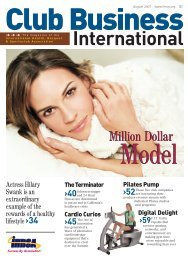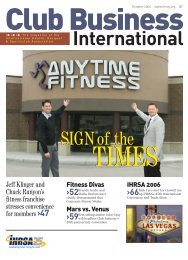Augie In Action! Augie In Action! - Ihrsa
Augie In Action! Augie In Action! - Ihrsa
Augie In Action! Augie In Action! - Ihrsa
You also want an ePaper? Increase the reach of your titles
YUMPU automatically turns print PDFs into web optimized ePapers that Google loves.
The Price is Right?<br />
By Patricia Amend<br />
What’s the best way to determine the appropriate price<br />
point for your membership? Should you, for example,<br />
“bundle” it with personal training and charge a<br />
higher price, or charge less and sell such services<br />
separately? Experts agree that your price doesn’t<br />
just affect your bottom line; it tells the marketplace<br />
what type of club you operate and who your<br />
target market is. Here, two of the industry’s<br />
best-known consultants discuss how to set<br />
the “right price.”<br />
Research your market. “People often tell me they know<br />
their market, and yet they haven’t done the research,”<br />
says Rick Caro, president of Management Vision, <strong>In</strong>c.,<br />
an industry consulting firm in New York City. “Market<br />
research and analysis can help determine your market<br />
potential, and may show, for example, that your<br />
market is stronger than you think, thus allowing for<br />
higher pricing.”<br />
Research the area that spans 6-8 minutes of travel<br />
time (walking or driving) from your club, says Mike Chaet,<br />
founder and president of CMS, <strong>In</strong>c., a health club<br />
consultancy based in Helena, Montana. “This is your<br />
market, from which you’ll get 80% of your members.”<br />
<strong>In</strong>clude demographics, such as educational attainment,<br />
occupation, age, ethnicity, and family income.<br />
Position yourself to prevent price competition. Use this<br />
research to position yourself clearly in your market,<br />
Caro urges. “If you don’t, the market will view you<br />
as similar to other clubs, and you may find yourself<br />
adjusting your joining fees and monthly dues slightly,<br />
in an attempt to differentiate yourself from the competition.<br />
Before long, you’ll be fighting the game of who<br />
has the deeper pockets.”<br />
Charge what you’re worth. Once positioned, Caro<br />
advises doing a good job of promoting your programs<br />
and services, and setting prices that reflect your positioning<br />
and inherent value. “If, for example, you charge<br />
upfront fees, you’re telling the membership that your<br />
club is worth that initial investment. They will have a<br />
| IHRSA Report | Club Advisor<br />
Price<br />
Boutique Clubs<br />
Big Box Clubs<br />
Larger Chains<br />
YMCAs<br />
Hotel Club Membership<br />
Recreation Centers<br />
School Fitness Centers<br />
Free Condo/Apt. Clubs<br />
Free Hotel Clubs<br />
Guest<br />
FREE MODEST MIDLINE UPPER END<br />
HIGH PERSONAL<br />
SERVICE<br />
Service<br />
Positioning Triad<br />
www.ihrsa.org | MARCH 2008 | Club Business <strong>In</strong>ternational 177<br />
GENERAL<br />
SERVICE<br />
VERY LOW<br />
SERVICE<br />
NONE OR SELF<br />
Graphic by CMS <strong>In</strong>ternational<br />
stake and will be less likely to resign, especially in the<br />
beginning. If you don’t, you’re telling them that your<br />
club is not worth it.”<br />
Bundle memberships—or not. When it comes to setting<br />
the actual price, Chaet points out that the more education<br />
and income people have, the greater the chance that<br />
they will pay a higher price for a “bundled” membership<br />
that includes some services. He offers the “Price/ Service<br />
Positioning Triad” (above), with high-service clubs at<br />
the top, and YMCAs and recreation centers at the bottom.<br />
“Americans spend an average of 1.2% of their household<br />
income on dues and other services in a health club. A<br />
household with $80,000 in income may spend as little<br />
as $800 or as much as $1,600 per year. If that’s your<br />
market, you may want to bundle your membership to<br />
include personal training or other services. However,<br />
if your member income level is $40,000-$80,000, and<br />
the member education level is lower, then you may<br />
want to offer a stripped-down membership, with<br />
services that people can add if they choose.<br />
Communicate price changes. When you must raise<br />
prices, be sure to inform members of the reasons behind<br />
the increase, so they continue to understand the price/<br />
value relationship in your club, Caro recommends.<br />
“Find out how members want to be communicated<br />
with—via your Website, a flyer, a bulletin board—and<br />
tell them about improvements that matter to them. If<br />
you don’t, then even a $2 per month increase will be<br />
upsetting to some.” —|
















